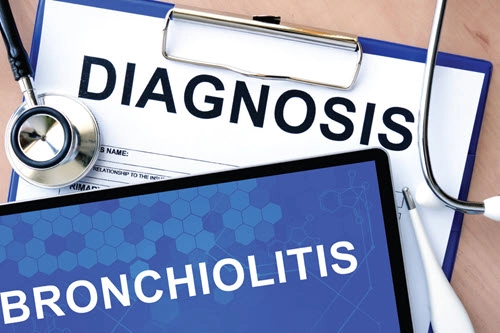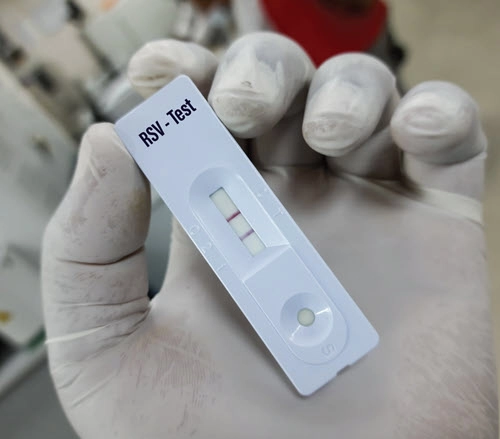Pediatric Coding Alert
Put Your Bronchiolitis Coding Skills to the Test With This Case Study
Remember the right way to count unique tests. Young infants with respiratory infections may be a common sight in your practice. But do you know the difference between coding for bronchitis and bronchiolitis? More, if your pediatrician tests for respiratory syncytial virus (RSV), do you count the test separately or as a part of the office/outpatient evaluation and management (E/M) service? If you’re not sure, here’s a case study for you to examine that will help you get it all straightened out. The Case: Your pediatrician meets with a 10-month-old female patient and her mother for the first time. The mother notes that the patient has had a cough, runny nose, nasal congestion, and a low-grade fever for three days, and this morning the patient was having breathing problems. The child has been lethargic and hasn’t been eating as much during this time. The mother denies the child has vomited or experienced diarrhea. There is nothing in the child’s history that is remarkable. The mother admits that both she and the father smoke, but the mother did not smoke during the pregnancy. On examination, the pediatrician notes the child is breathing fast and with difficulty. She is wheezing and the pediatrician detects crackles. The patient’s heart rate is higher than normal, and her oxygen saturation is low. Your pediatrician orders a rapid antigen test for RSV, which comes back positive. The pediatrician then diagnoses the child with acute bronchiolitis due to RSV and recommends over-the-counter remedies such as saline nose drops and acetaminophen or ibuprofen for the fever. Code the Encounter To code the office/outpatient evaluation and management (E/M) service for this encounter correctly, you first need to know how to classify bronchiolitis in terms of its complexity. Once you know that “most cases [of bronchiolitis] go away on their own and can be cared for at home,” according to the American Lung Association (Source: www.lung.org/lung-health-diseases/lung-disease-lookup/bronchiolitis/symptoms-diagnosis-treatment), then you can calculate the level of medical decision making (MDM) for the encounter. Bronchiolitis fits neatly into the definition of a self-limited or minor problem per the CPT® office/outpatient E/M service guidelines. This is a problem that “runs a definite and prescribed course, is transient in nature, and is not likely to permanently alter health status.” CPT® assigns a minimal level of MDM for a single self-limited or minor problem per the Elements of MDM table. Similarly, the risk level is minimal, as the only course of treatment is with over-the-counter medications. Can you count the test? Even if you bill for the test using a CPT® code — in this case, most likely 87807 (Infectious agent antigen detection by immunoassay with direct optical (ie, visual) observation; respiratory syncytial virus) — you can still count the test order as an MDM element and bill the test separately. As the AMA clarifies, “Tests that do not require separate interpretation (e.g., tests that are results only) and are analyzed as part of MDM … may be counted as ordered or reviewed for selecting an MDM level,” and that “any specifically identifiable procedure or service (i.e., identified with a specific CPT® code) performed on the date of E/M services may be reported separately” (Source: www.ama-assn.org/system/files/cpt-corrections-errata-2021.pdf). That, combined with the mother’s role as an independent historian in the encounter, suggests you can assign a limited MDM level for the amount and/or complexity of data category, and you can assign a limited level to the data category of MDM. But as both the problem element and risk element levels are minimal, the overall MDM level only rises to straightforward. This means you can safely assign 99202 (Office or other outpatient visit for the evaluation and management of a new patient, which requires a medically appropriate history and/or examination and straightforward medical decision making …) to this scenario as the patient was not established to the practice prior to the encounter. But don’t forget this modifier: As 87807 is a Clinical Laboratory Improvement Amendments (CLIA)-waived test, you will need to append QW (CLIA waived test) to the 87807 before submitting your bill. Code the Diagnosis “The age of onset of bronchitis and bronchiolitis is different in that bronchiolitis is an infant to early childhood illness, while bronchitis is never seen in this age range but is more likely seen in teens and adults,” according to Melanie Witt, RN, CPC, MA, an independent coding expert based in Guadalupita, New Mexico. So, you would fully expect your pediatrician to bypass J20.- (Acute bronchitis), J40 (Bronchitis, not specified as acute or chronic), J41.- (Simple and mucopurulent chronic bronchitis), or J42 (Unspecified chronic bronchitis) in favor of either J21.- (Acute bronchiolitis) or J44.- (Other chronic obstructive pulmonary disease) in the case of chronic bronchiolitis. Narrowing it down: “Because we have codes for acute bronchiolitis caused by specific infectious agents, codes from Chapter 1, Certain Infectious and Parasitic Diseases [A00-B99], are not needed,” JoAnne M. Wolf, RHIT, CPC, CEMC, AAPC Fellow, coding manager at Children’s Health Network in Minneapolis, reminds coders. “Acute bronchitis due to RSV is a good example of that, so B97.4 [Respiratory syncytial virus as the cause of diseases classified elsewhere] is not needed. Instead, you would code it as J21.0 [Acute bronchiolitis due to respiratory syncytial virus] since the infection is specified in J21.0,” Wolf adds. Add These Codes as Appropriate Last, you must use an additional code per the instructional note for Chapter 10, Diseases of the respiratory system (J00-J99), which requires you to identify a patient’s tobacco use and/ or exposure. In this case, if the pediatrician’s documentation indicates it, you will add P96.81 (Exposure to (parental) (environmental) tobacco smoke in the perinatal period) for the father’s smoking. And even though the code stipulates exposure to environmental tobacco smoke, you could also add Z77.22 (Contact with and (suspected) exposure to environmental tobacco smoke (acute) (chronic)) as both codes have reciprocal Excludes2 instructions allowing you to code them both if appropriate.

Related Articles
Pediatric Coding Alert
- Condition Spotlight:
Delve Into These Details for Depression Dx
Quickly arrive at the correct code choice and stay ahead of the pandemic curve. Has [...] - Test Yourself:
Put Your Bronchiolitis Coding Skills to the Test With This Case Study
Remember the right way to count unique tests. Young infants with respiratory infections may be [...] - Procedure Coding:
Take These 4 Tips for Accurate Lesion Removal Coding
Know the why, what, and where, and let your code choice measure up. Skin conditions [...] - You Be the Coder:
Answer This Question, Assign Z79 Codes Correctly
Question: I always thought you billed Z79.899 whenever a patient was taking a long-term medication [...] - Reader Questions:
Boost Your Pfizer COVID Vaccine Third Dose Administration Understanding
Question: I am confused about the correct administration code to use for the third pediatric [...] - Reader Questions:
Separate These Outpatient and Inpatient Encounters for Correct Billing
Question: If a pediatrician sees a patient earlier in the day at our practice, then [...] - Reader Questions:
Unspecify the Relationship in This Neonatal Jaundice Case
Question: Our pediatrician documented that a neonate had jaundice; the baby had been born preterm at [...]




